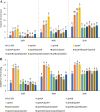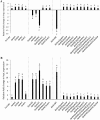Phosphodiesterase Genes Regulate Amylovoran Production, Biofilm Formation, and Virulence in Erwinia amylovora
- PMID: 30366999
- PMCID: PMC6293108
- DOI: 10.1128/AEM.02233-18
Phosphodiesterase Genes Regulate Amylovoran Production, Biofilm Formation, and Virulence in Erwinia amylovora
Abstract
Cyclic di-GMP (c-di-GMP) is a ubiquitous bacterial second messenger molecule that is an important virulence regulator in the plant pathogen Erwinia amylovora Intracellular levels of c-di-GMP are modulated by diguanylate cyclase (DGC) enzymes that synthesize c-di-GMP and by phosphodiesterase (PDE) enzymes that degrade c-di-GMP. The regulatory role of the PDE enzymes in E. amylovora has not been determined. Using a combination of single, double, and triple deletion mutants, we determined the effects of each of the four putative PDE-encoding genes (pdeA, pdeB, pdeC, and edcA) in E. amylovora on cellular processes related to virulence. Our results indicate that pdeA and pdeC are the two phosphodiesterases most active in virulence regulation in E. amylovora Ea1189. The deletion of pdeC resulted in a measurably significant increase in the intracellular pool of c-di-GMP, and the highest intracellular concentrations of c-di-GMP were observed in the Ea1189 ΔpdeAC and Ea1189 ΔpdeABC mutants. The regulation of virulence traits due to the deletion of the pde genes showed two patterns. A stronger regulatory effect was observed on amylovoran production and biofilm formation, where both Ea1189 ΔpdeA and Ea1189 ΔpdeC mutants exhibited significant increases in these two phenotypes in vitro In contrast, the deletion of two or more pde genes was required to affect motility and virulence phenotypes. Our results indicate a functional redundancy among the pde genes in E. amylovora for certain traits and indicate that the intracellular degradation of c-di-GMP is mainly regulated by pdeA and pdeC, but they also suggest a role for pdeB in regulating motility and virulence.IMPORTANCE Precise control of the expression of virulence genes is essential for successful infection of apple hosts by the fire blight pathogen, Erwinia amylovora The presence and buildup of a signaling molecule called cyclic di-GMP enables the expression and function of some virulence determinants in E. amylovora, such as amylovoran production and biofilm formation. However, other determinants, such as those for motility and the type III secretion system, are expressed and functional when cyclic di-GMP is absent. Here, we report studies of enzymes called phosphodiesterases, which function in the degradation of cyclic di-GMP. We show the importance of these enzymes in virulence gene regulation and the ability of E. amylovora to cause plant disease.
Keywords: EAL domain; cyclic di-GMP; exopolysaccharide; fire blight; flagellar motility; levan.
Copyright © 2018 American Society for Microbiology.
Figures








Similar articles
-
The RNA-Binding Protein ProQ Impacts Exopolysaccharide Biosynthesis and Second Messenger Cyclic di-GMP Signaling in the Fire Blight Pathogen Erwinia amylovora.Appl Environ Microbiol. 2022 May 10;88(9):e0023922. doi: 10.1128/aem.00239-22. Epub 2022 Apr 13. Appl Environ Microbiol. 2022. PMID: 35416685 Free PMC article.
-
Cyclic Di-GMP modulates the disease progression of Erwinia amylovora.J Bacteriol. 2013 May;195(10):2155-65. doi: 10.1128/JB.02068-12. Epub 2013 Mar 8. J Bacteriol. 2013. PMID: 23475975 Free PMC article.
-
Cellulose production, activated by cyclic di-GMP through BcsA and BcsZ, is a virulence factor and an essential determinant of the three-dimensional architectures of biofilms formed by Erwinia amylovora Ea1189.Mol Plant Pathol. 2018 Jan;19(1):90-103. doi: 10.1111/mpp.12501. Epub 2016 Dec 18. Mol Plant Pathol. 2018. PMID: 27753193 Free PMC article.
-
Virulence Factors of Erwinia amylovora: A Review.Int J Mol Sci. 2015 Jun 5;16(6):12836-54. doi: 10.3390/ijms160612836. Int J Mol Sci. 2015. PMID: 26057748 Free PMC article. Review.
-
Molecular genetics of Erwinia amylovora involved in the development of fire blight.FEMS Microbiol Lett. 2005 Dec 15;253(2):185-92. doi: 10.1016/j.femsle.2005.09.051. Epub 2005 Oct 13. FEMS Microbiol Lett. 2005. PMID: 16253442 Review.
Cited by
-
Cell cycle control and environmental response by second messengers in Caulobacter crescentus.BMC Bioinformatics. 2020 Sep 30;21(Suppl 14):408. doi: 10.1186/s12859-020-03687-z. BMC Bioinformatics. 2020. PMID: 32998723 Free PMC article.
-
Genomic insights into novel Erwinia bacteriophages: unveiling their Henunavirus membership and host infection strategies.Curr Microbiol. 2024 Jun 3;81(7):204. doi: 10.1007/s00284-024-03713-w. Curr Microbiol. 2024. PMID: 38831133
-
A novel phytopathogen Erwinia sorbitola sp. nov., isolated from the feces of ruddy shelducks.Front Cell Infect Microbiol. 2023 Feb 16;13:1109634. doi: 10.3389/fcimb.2023.1109634. eCollection 2023. Front Cell Infect Microbiol. 2023. PMID: 36875519 Free PMC article.
-
The RNA-Binding Protein ProQ Impacts Exopolysaccharide Biosynthesis and Second Messenger Cyclic di-GMP Signaling in the Fire Blight Pathogen Erwinia amylovora.Appl Environ Microbiol. 2022 May 10;88(9):e0023922. doi: 10.1128/aem.00239-22. Epub 2022 Apr 13. Appl Environ Microbiol. 2022. PMID: 35416685 Free PMC article.
-
A complete twelve-gene deletion null mutant reveals that cyclic di-GMP is a global regulator of phase-transition and host colonization in Erwinia amylovora.PLoS Pathog. 2022 Aug 1;18(8):e1010737. doi: 10.1371/journal.ppat.1010737. eCollection 2022 Aug. PLoS Pathog. 2022. PMID: 35914003 Free PMC article.
References
-
- Thomson SV. 1986. The role of the stigma in fire blight infections. Phytopathology 76:476–482. doi:10.1094/Phyto-76-476. - DOI
-
- Van der Zwet T, Beer SV. 1995. Fire blight—its nature, prevention, and control. A practical guide to integrated disease management. USDA agriculture information bulletin no. 631. U.S. Department of Agriculture, Washington, DC.
-
- Eden-Green SJ, Knee M. 1974. Bacterial polysaccharide and sorbitol in fireblight exudate. J Gen Microbiol 81:509–512. doi:10.1099/00221287-81-2-509. - DOI
Publication types
MeSH terms
Substances
Grants and funding
LinkOut - more resources
Full Text Sources

